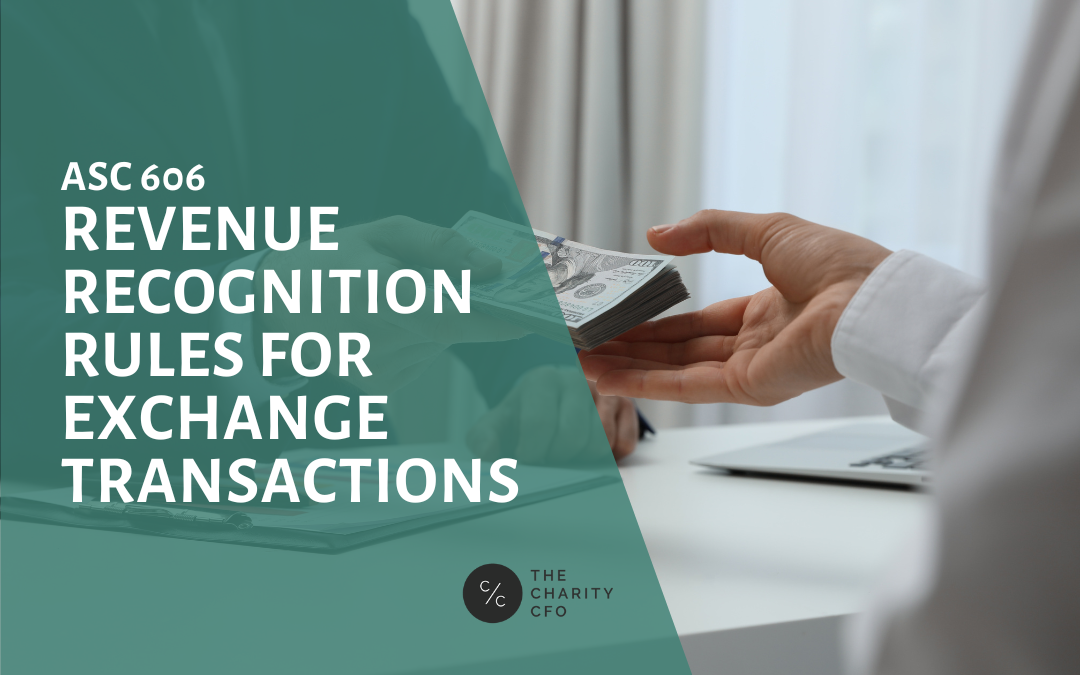All US businesses, for-profit and nonprofit, were subject to new revenue recognition standards starting by 2019. These new standards are detailed in ASC 606 and impact all companies that contract with customers to transfer goods or services.
Nonprofit accounting departments often move slowly, so while hopefully you’ve already implemented these standards, you should ensure that you have. And if you’re having trouble understanding what they mean to you, this article is for you.
Note: While often referred to as the “new revenue recognition standards,” ASC 606 has been in force since 2019 for most nonprofits. ASC 606 is often confused with ASC 958 (which addresses nonprofit entities’ financial statements). Nonprofit entities should understand ASC 958 and ASC 606, but this article focuses solely on ASC 606.
What Is ASC 606? And Does It Impact Nonprofits?
ASC 606 is a relatively new set of rules for revenue recognition. The Financial Accounting Standards Board (also known as the FASB) defines and codifies all nonprofit accounting regulations here in the United States, so this falls under FASB jurisdiction.
By 2019, most nonprofit organizations were required to adopt and implement these new rules associated with revenue from “exchange transactions.” These rules are called “ASC 606,” in which “ASC” stands for Accounting Standards Certification, and “606” represents the portion of FASB’s guidance in which revenue from contracts with customers is covered.
While the standards have been in effect for at least 2 years, you may still hear ASC 606 referred to as ‘“the new revenue recognition standards.”
This article offers a refresher outlining ASC 606 for nonprofits and what the rules cover. For a more in-depth discussion of ASC 606, please see FASB Accounting Standards Update.
Exchange Revenue vs. Non-Exchange Revenue
Nonprofit entities deal with two primary types of revenue, so confusing exchange and non-exchange revenue is easy to do. To separate the two, consider exchange revenue first.
Exchange revenue is revenue earned anytime you provide goods or services in exchange for money. It’s what we automatically think of when we consider traditional “for profit” scenarios.
The key word here is “exchange” – so, when you think of exchange revenue, think of exchanging goods or services for money.
On the other hand, non-exchange revenue (or contributed revenue) is unique to the nonprofit sector. Unlike traditional “for profit” scenarios, non-exchange revenue scenarios encompass any situation where a benefactor or donor contributes money or in-kind gifts expecting nothing in return.
Distinguishing these two is essential, especially since ASC 606 only encompasses exchange revenue, excluding non-exchange revenue entirely. ASC 958, a separate section of the Accounting Standards Codification, covers recognition standards associated with non-exchange or contributed revenue.
So, while many nonprofit organizations earn exchange revenue, this isn’t the case for all. Because some nonprofits don’t earn exchange revenue, ASC 606 doesn’t apply to all nonprofit organizations.
Does ASC 606 Apply To My Nonprofit?
ASC 606 might not apply to your nonprofit, but it’s easy to determine whether it affects your organization or not.
For example, if you sell goods or services at any point throughout the year, ASC 606 applies to your nonprofit. This includes organizations that:
- Sell services, merchandise, or other goods and products, as this falls under the purview of ASC 606.
- Hosts galas or other fundraising events where guests are charged admission, resulting in exchange revenue, hence the adherence to ASC 606.
In addition to these scenarios, ASC 606 rules apply to somewhat unconventional settings. For example, some organizations don’t charge participants for their services but bill a third party for the services rendered (including Medicaid or insurance companies). While it might not be a classic display of exchange revenue, this still classifies as such and falls under the ASC 606 regulations.
Aside from this, other areas you might consider part of the ASC 606 might not fall under these regulations. For example, gifts, contributions, and grants paid to your organization aren’t considered exchange revenue, even if they’re restricted for specific purposes. Due to this classification, gifts, contributions, and grants are exempt from ASC 606.
How Does ASC 606 Work?
ASC 606 outlines a 5-step process that accountants can use to analyze an organization’s exchange-based revenue stream. Using this process, accountants can determine when and how to recognize revenue on income statements or statements of activities.
ASC 606 5-Step Process
Upon a first look, the five-step process, as outlined by AICPA, can seem quite intimidating. However, despite the overwhelming appearance, it’s based on a straightforward principle: revenue can only be recognized when (or as) goods or services are provided.
So, it doesn’t matter when the customer actually pays. For example, the customer could pay you before receiving the goods or services, but you still recognize that payment as deferred revenue until meeting the performance obligation.
Or, if a customer pays after you provide the goods or services, you can recognize revenue once you meet the obligation and record the transaction in accounts receivable until the customer makes the payment.
Applying the five-step revenue recognition process varies from one organization to the next, but here’s what the base process entails.
1. Identify The Contract With The Customer
The first step in this process involves identifying the contract with the customer. Any time the nonprofit has an agreement with a third party to exchange goods or services for anything of monetary value, there is a contract.
For instance, when you buy a book from a local nonprofit bookstore, you enter into a contract. While the agreement isn’t explicitly written, this concept remains true from a technical standpoint. So, the first step in analyzing your organization’s revenue is to identify when your customers enter contracts with you.
2. Identify The Performance Obligation(s) In The Contract
Secondly, you need to identify the performance obligations stipulated in the contract. The performance obligation is straightforward: it is what the customer pays for.
In some cases, the contract may involve multiple performance obligations. For example, a nonprofit organization that is providing consulting services might outline multiple separate “milestones” throughout a 2-year contract. These milestones could include reports, presentations, or whitepapers that might be considered each a different performance obligation, making up parts of a larger contract.
Ultimately, a nonprofit can’t recognize this until a performance obligation is met. For example, suppose your nonprofit receives a payment of $5,000 in advance to perform consulting work at a future date. In that case, you cannot consider that money to be “revenue” until you begin to meet the performance obligations.
3. Determine The Transaction Price
Next, you need to determine the transaction price. In some contracts, this step is simple. For example, if you sell a book for $10, its transaction price is $10.
However, if you engage in a contract for consulting services where your total contract price totals $10,000, but there are several separate performance obligations with numerous components and considerations, this becomes more complex.
When you offer discounts, you must remove them from the total price if the discounts are considered likely to be exercised.
4. Allocate The Transaction Price To Performance Obligations
In the fourth step, you must allocate the transaction price to the performance obligations. Circle back to the example of the $10 book – if you sell a distinct good or service and there is only a single performance obligation, this is simple. You sell the book for $10, so the performance obligation (the book) is directly associated with the $10 price tag.
However, if you’re providing consulting services with a set of milestones (or performance obligations) for a single total transaction price, you need to estimate the relative value of each milestone. Consider the example of a $10,000 consulting contract. If you break this into milestones, it might look somewhat like this:
- $1,000 for the initial assessment and report
- $4,000 for the board presentation
- $5,000 for the whitepaper at the end of the engagement
Of course, the contract might not divide the pricing like this, so you may have to estimate the allocation of price to each separate performance obligation.
5. Recognize Revenue When (Or As) The Entity Satisfies A Performance Obligation
The final step in the process is recognizing the revenue. Once you sell a book for $10 (or whatever the price), you can immediately acknowledge revenue once you hand the book to the customer, as the performance obligation is complete.
Or, if you’re providing consulting services, you may only recognize revenue as each performance obligation is met based on the relative value you assign to each obligation. Based on the example above, you could recognize the first $1,000 in revenue after completing the initial assessment and report. Then, after completing the whitepaper, you can recognize the final $5,000 from the contract as revenue.
What About Contributed/Non-Exchange Revenue?
ASC 606 and exchange revenue are entirely different from contributed or non-exchange revenue. Although we’ll cover contributed or non-exchange revenue in a future article, it’s essential to note these differences.
ASC 958, the section that covers contributed and non-exchange revenue, is entirely different from ASC 606, which we outlined in this article. Therefore, it’s essential you don’t confuse the two sets of regulations. Many nonprofits have exchange and non-exchange revenue, so understanding both sets of standards and how they impact your revenue streams is imperative.
Understanding ASC 606 for Your Nonprofit
While we’ve referred to ASC 606 as the “new revenue recognition standards” for nearly a decade, they’re far from new. However, just because these rules have been around for a few years doesn’t mean everyone fully understands them. For your nonprofit to run smoothly and compliantly, you must understand how ASC 606 impacts your organization.
Contact Our Accounting Team Of Former Nonprofit Auditors Today
If ASC 606 is foreign to you, or you haven’t implemented its standards, there’s a good chance your current accounting setup isn’t working as well as it could.
There’s no need to worry—many CPAs and accounting firms don’t regularly work with nonprofits. Due to their lack of regularity working with these organizations, it’s easy for these standards to go unnoticed. However, this means that certain CPAs may not regularly be familiar with straightforward solutions for challenges your organization faces.
Here at The Charity CFO, our focus is exclusively on nonprofit organizations. We focus on these organizations to provide knowledgeable assistance with bookkeeping, accounting, and reporting needs. Our team, including five former nonprofit auditors, is well-versed in the specifics of nonprofit standards and can efficiently handle any financial challenge you face.
Interested to hear more about how we can help? Contact us today to schedule a free consultation.

Do You Struggle to Make Sense of Your Financial Statements?
Get our FREE GUIDE to nonprofit financial reports, featuring illustrations, annotations, and insights to help you better understand your organization's finances.
Get the free guide!



0 Comments